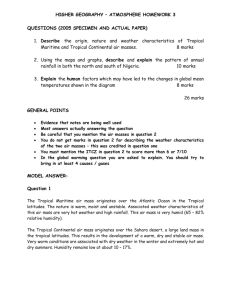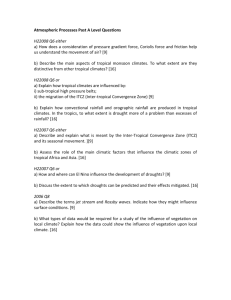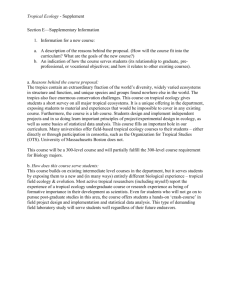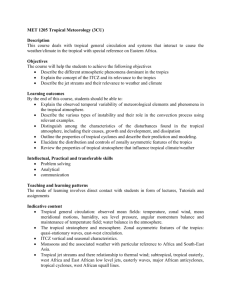general contents
advertisement
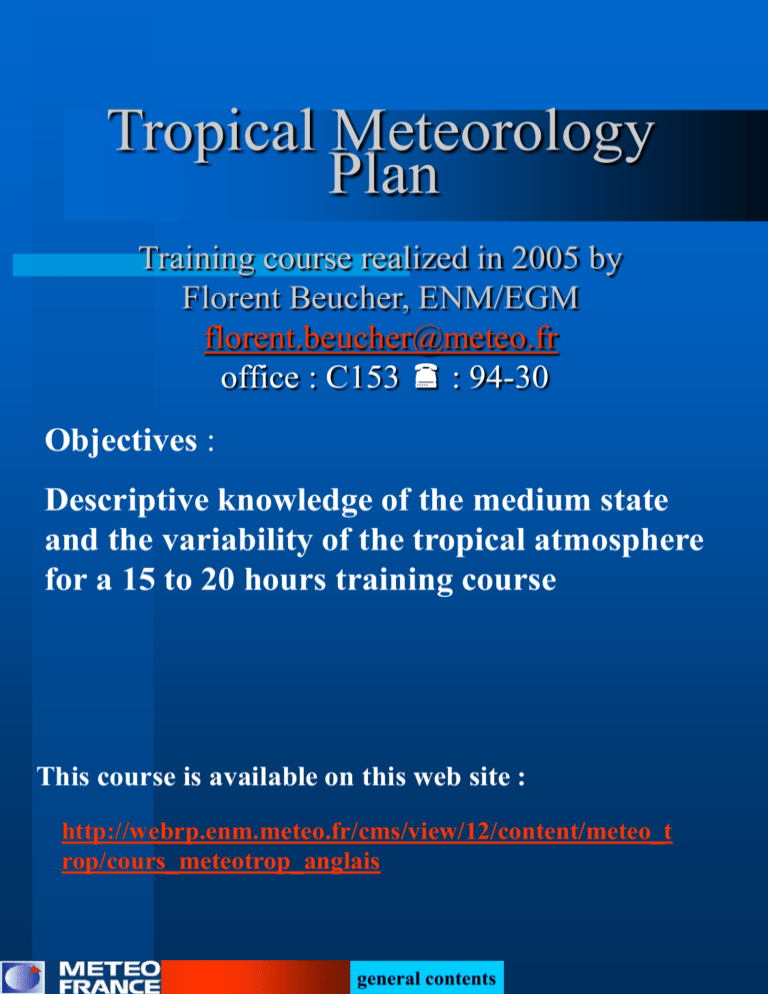
Tropical Meteorology Plan Training course realized in 2005 by Florent Beucher, ENM/EGM florent.beucher@meteo.fr office : C153 : 94-30 Objectives : Descriptive knowledge of the medium state and the variability of the tropical atmosphere for a 15 to 20 hours training course This course is available on this web site : http://webrp.enm.meteo.fr/cms/view/12/content/meteo_t rop/cours_meteotrop_anglais general contents Tropical Meteorology Bibliography of this course : • S.Hastenrath : Climate and circulations of the tropics, 1985 • G.C Asnani : Tropical Meterology (Vol.1 et vol.2), 1982 • Adrian E. Gill : Atmosphere-Ocean Dynamics (chap.11 on tropics) • Ding Yihui : China Monsoon,1994 • Herbert Riehl : Climate and Weather in the tropics, 1979 • Robert A. Houze : Clouds dynamics • In French : OMM n° 305 : guide su systeme mondial du traitement des données, chap.5 , written in 1993 • And various paper from JAS, MWR etc… More details about tropical meteorology on UFR Web-site : http://intra-ufr.enm.meteo.fr/pages/UFR/ufr_index.htm general contents Tropical Meteorology Definition : • Tropics are located between the both belt of subtropical high pressure = about 50% of the sphere (30°N/30°S) • These belts as the tropic regions move with the season. Location of tropical atmosphere in annual mean or at equinox : Ridge = 30°N A Equator Ridge = 30°S general contents A Tropical Meteorology Definition : • Tropics are located between the both belt of subtropical high pressure = about 50% of the sphere (30°N/30°S) • These belts as the tropic regions move with the season. Location of tropical atmosphere in august : Ridge = 35°N A Northward shift of tropical atmosphere from february to august Equator Ridge = 25°S general contents A Tropical Meteorology Definition : • Tropics are located between the both belt of subtropical high pressure = about 50% of the sphere (30°N/30°S) • These belts as the tropic regions move with the season. Location of the tropical atmosphere in february : Ridge = 25°N A Equator Ridge = 35°S general contents A Southward shift of tropical atmosphere from from august to february Météorologie Tropicale Location of the tropical atmosphere in february : - Realize a radiosondage in the summer hemisphere of the tropical atmosphere : = vertical sounding Ridge = 25°N A Southward shift of tropical atmosphere from from august to february equator Ridge = 35°S general contents A • As the tropical atmosphere is nearly barotropic, the vertical shear is light : - trades winds in low tropo. (5 à 10kt) - easterlies in mid-tropo. (10kt) - easterlies in upper tropo. (20 kt) • This representative vertical souding centre de la is observed dorsale = 25°N : A - in february within a latitud band 10°N-15°S, - in august within a latitud band 30°N-10°S general contents Météorologie Tropicale Location of the tropical atmosphere in february : - Realize a radiosondage in the winter hemisphere of the tropical atmosphere : = vertical sounding Ridge = 25°N A Southward shift of tropical atmosphere from from august to february equator Ridge = 35°S general contents A Radiosondage Analyse ARP1.5 Source : Météo-France • On the poleward flanks of the tropical atmosphere, the baroclinicity and the vertical wind shear increase : • Comme l’atmosphère tropicale - trades winds in low tropo. (5 à 10kt) est quasi-barotrope, le cisaillement - light westerlies in mid-tropo. (10kt) vertical de vent est faible tropo. : - strong westerlies in upper (60 kt)= - alizés JOST en basses couches (5 à 10kt) - vent d’est en moyenne tropo (10kt) d’est enduring hautethe tropo (20season kt) in •- vent For instance, winter the french tropical islands, the mean state of theradiosondage tropical atmosphere nearly behaves: • Ce typique s’observe centre defévrier la like in mid-latitudes. The theory of en entre 10°N-15°S, A dorsale = 25°N Anasyg-Presyg could be work ? - en août entre 30°N-10°S • This representative vertical sounding is observed : : -in february northward of 15°N and southward of 25°S, -in august northward of 35°N and southward of 15°S general contents Tropical Meteorology 5 main characteristics of the tropics : The first three ones because of radiative considerations: ① Between 30°S/30°N, radiative energy >0 at the top of atmosphere Outward tropics, radiative energy <0 at the top of atmosphere : ⇨ we observe a strong meridional radiative desequilibrium between the equator and the poles ⇨ initiates a planetary-scale meridian circulation in atmopshere called ‘Hadley Cell’ ⇨ initiates a planetary-scale ocean circulation directed northward (Gulf Stream, Kuroshio etc..) ② Close to the equator, the radiative energy is much higher at surface than at the top of atmosphere : ⇨ we observe a strong vertical radiative desequilibrium between surface and top of atmosphere ⇨ initiates strong vertical velocities = ascent branch of both Walker cells and Hadley cells ③ Diurnal variability is higher than annual variability ⇨ the diurnal cycle is very important under tropics general contents Tropical Meteorology 5 main characteristics of the tropics (the continuation) : The last two ones because of light Coriolis parameter f (10-5 s-1 at 10° of latitude) : ④ Horizontal gradient of geopotential slack compared with mid-latitude ⇨ the tropics are nearly ‘barotropic’ ⑤ The flow is essentially divergent in tropics, i.e. the rotational part of the flow is insignificant except two cases : - at planetary scale as equatorial waves (geostrophic balance) - cyclones (cyclostrophic balance) general contents Plan 1. Different scales of the atmosphere 2. Energy sources for the initiation and the growth of the equatorial waves and tropical disturbances 3. Regional climates in tropics 4. Equatorial trapped waves and planetary waves oscillations (MJO,QBO) 5. Conceptual models of synoptic tropical disturbances in summer 6. Interactions between the mid-latitudes and the tropics 7. ENSO Chap.1 Different scales of the atmosphere Meso-scale or convective scale = ‘little scale’ Synoptic or Planetary scale = ‘large scale’ R ~ NH/(f+ ζr) Atmospheric deformation radius (depends on f, stability of the atmosphere and the relative vorticity) R (km) Tropics 1000 Mid100 Latitudes Tropical 10 Cyclone Moist convective instablility 3D 10 000 H thickness of the atmosphere Quasi-horizontal balanced flow : Geostophic and hydrostatic equilibrium 10 km 1 1 10 100 1000 10 000 Source : Ooyama 1982 general contents L (km) = Horizontal scale Plan 1. Different scales of the atmosphere 2. Energy sources for the initiation and the growth of the equatorial waves and tropical disturbances 3. Regional climates in tropics 4. Equatorial trapped waves and planetary waves oscillations (MJO,QBO) 5. Conceptual models of synoptic tropical disturbances in summer 6. Interactions between the mid-latitudes and the tropics 7. ENSO Chap 2. Energy sources for the initiation and growth of the equatorial waves and tropical disturbances Interactions between the convection (little scale) and larger scales : 200 hPa 200 hPa 850 hPa 850 hPa Source : Météo-France Lafore time ⇨ The convection produces synoptic disturbances over a horizontal-scale λR (about 1000 km under tropics) after 1/f time-scale (about 1 day under tropics) ⇨ Interactions between convection and larger scale are realized through inertial-gravity waves (IG) ⇨ But this interaction is efficient only if release of latent heat is important (big population of cumulonimbus) general contents Chap 2. Energy sources for the initiation and growth of the equatorial waves and tropical disturbances Illustration of this process at the end of May after the Indian Monsoon onset : H H H Géopotentiel at 200 hPa; 22/07/05; Analyse CEP 1.5. Source : Météo-France • All over tropics [30°N-30°S], by thermal forcing we observe high geopotential but with a slack gradient since tropics are nearly barotropic • By release of latent heat over Indian and Asian monsoon occur an increase of geopotential general contents Plan 1. Different scales of the atmosphere 2. Energy sources for the initiation and the growth of the equatorial waves and tropical disturbances 3. Regional climates in tropics 4. Equatorial trapped waves and planetary waves oscillations (MJO,QBO) 5. Conceptual models of synoptic tropical disturbances in summer 6. Interactions between the mid-latitudes and the tropics 7. ENSO Plan 1. Different scales of the atmosphere 2. Energy sources for the initiation and the growth of the equatorial waves and tropical disturbances 3. Regional climates in tropics 4. Equatorial trapped waves and planetary waves oscillations (MJO,QBO) 5. Conceptual models of synoptic tropical disturbances in summer 6. Interactions between the mid-latitudes and the tropics 7. ENSO Plan 1. Different scales of the atmosphere 2. Energy sources for the initiation and the growth of the equatorial waves and tropical disturbances 3. Regional climates in tropics 4. Equatorial trapped waves and planetary waves oscillations (MJO,QBO) 5. Conceptual models of synoptic tropical disturbances in summer 6. Interactions between the mid-latitudes and the tropics 7. ENSO Plan 1. Different scales of the atmosphere 2. Energy sources for the initiation and the growth of the equatorial waves and tropical disturbances 3. Regional climates in tropics 4. Equatorial trapped waves and planetary waves oscillations (MJO,QBO) 5. Conceptual models of synoptic tropical disturbances in summer 6. Interactions between the mid-latitudes and the tropics 7. ENSO Plan 1. Different scales of the atmosphere 2. Energy sources for the initiation and the growth of the equatorial waves and tropical disturbances 3. Regional climates in tropics 4. Equatorial trapped waves and planetary waves oscillations (MJO,QBO) 5. Conceptual models of synoptic tropical disturbances in summer 6. Interactions between the mid-latitudes and the tropics 7. ENSO Meridional desequilibrium energy : Hadley cell in annual mean km Modèle 2D méridien ; Source : Météo-France Circulation linked to the Hadley cell of Southern hemisphere -100 W/m2 Circulation linked to the Hadley cell of Northern hemisphere + 60 W/m2 °S -100 W/m2 °N Between 30°S/30°N, the radiative energy is positive at the top of atmosphere (# 60 W/m2 at equator): ⃗ Planetary-scale meridian circulation called ‘Hadley Cell’ general contents Seasonal variability : Hadley cell in march (spring equinox) Modèle 2D méridien ; Source : Météo-France ITCZ located at equator general contents Seasonal variability of the Hadley cell from march to july Modèle 2D méridien ; Source : Météo-France ITCZ located at 1°N general contents Seasonal variability of the Hadley cell from march to july Modèle 2D méridien ; Source : Météo-France ITCZ located at 2°N general contents Seasonal variability of the Hadley cell from march to july Modèle 2D méridien ; Source : Météo-France ITCZ located at 3°N general contents Seasonal variability of the Hadley cell from march to july Modèle 2D méridien ; Source : Météo-France ITCZ located at 4°N general contents Seasonal variability of the Hadley cell from march to july Modèle 2D méridien ; Source : Météo-France ITCZ located at 5°N general contents Seasonal variability of the Hadley cell from march to july Modèle 2D méridien ; Source : Météo-France ITCZ located at 6°N general contents Seasonal variability of the Hadley cell from march to july Modèle 2D méridien ; Source : Météo-France ITCZ located at 7°N general contents Seasonal variability of the Hadley cell from march to july Modèle 2D méridien ; Source : Météo-France ITCZ located at 8°N general contents Seasonal variability of the Hadley cell from march to july Modèle 2D méridien ; Source : Météo-France ITCZ located at 9°N general contents Seasonal variability of the Hadley cell from march to july Modèle 2D méridien ; Source : Météo-France ITCZ located at 10°N general contents Seasonal variability of the Hadley cell from march to july Modèle 2D méridien ; Source : Météo-France ITCZ located at 11°N general contents Seasonal variability of the Hadley cell from march to july Modèle 2D méridien ; Source : Météo-France ITCZ located at 12°N general contents Seasonal variability : Hadley cell in july Circulation linked to the Hadley cell of the winter hemisphere, 10 times more developped than in summer Circulation linked to the Hadley cell of summer hemisphere + 100 W/m2 - 180 W/m2 STJ STJ Modèle 2D méridien ; Source : Météo-France °S - 80 W/m2 ITCZ °N 12°N Retour début animation ⇨ Consequently, the upper troposheric jet at 30° of latitude, called ‘subtropical Jet or STJ’ is much more developped in the winter hemisphere than in the summer hemisphere general contents Vertical desequilibrium energy : Walker and Haldey cells Source : Météo-France. Florent Beucher Close to the equator, the radiative energy is much higher at surface (+140 W/m2) than at the top of atmosphere (+60 W/m2) : ⇨ we observe a strong vertical radiative desequilibrium between surface and top of atmosphere ⇨ initiates strong vertical velocities = ascent branch of both Walker cells and Hadley cells general contents Walker cell : Shematic description z equator Annual mean [15°S-15°N] vertical cross-section of circulation Source : Newell, 1979 • When vertical- zonal circulations are averaged over one year and over a latitude band 15°N-15°S, the averaged circulation is nearly vertical-equatorial (see the figure above) and called ‘Walker cell’ • The 3 ascending branches explains the 3 deep convection pole : Africa, Indonesia in january then India in july, Central America • The 3 descending branches explains subsidence over Eastern Pacific, Eastern Atlantic and Western Ocean Indian general contents References - De Moor G. et P. Veyre, 1991 : ‘Les bases de la météorologie dynamique’ Cours et Manuel n°6 - p.193 - Lafore : Support de cours ‘Convection’, Partie 2 écrite par J. P. Lafore CNRM/GMME. - Morel P. éditeur (1973) : ‘Dynamic Meteorology’ –D. Reidel Publishing Company – 622 p. - Newell, R. E., 1979 : ‘Climate and the Ocean’ . Amer. Sci., 67, pp. 405-416 - Ooyama, 1982 : ‘Conceptual evolution of the theory and modeling of the tropical cyclone. J. Meteor. Soc. Japan,, 60, pp. 369-380

